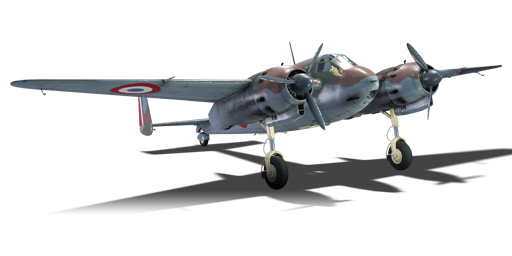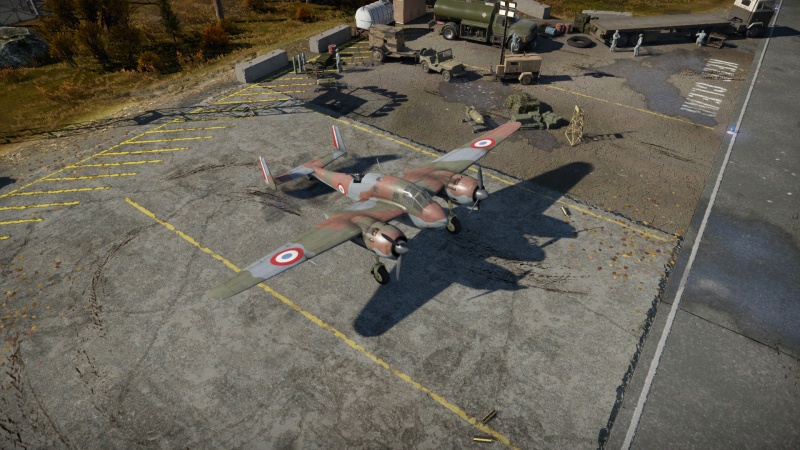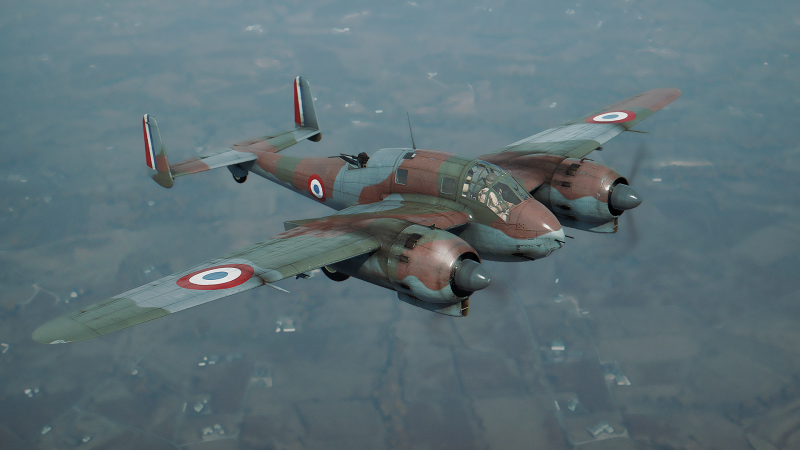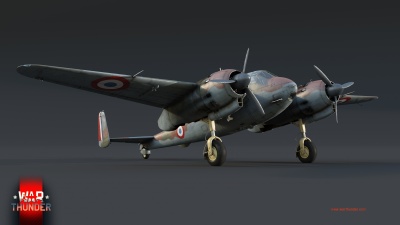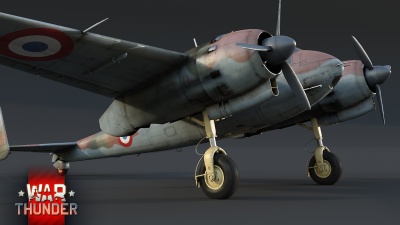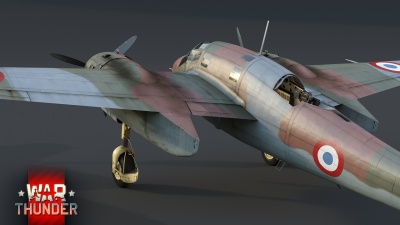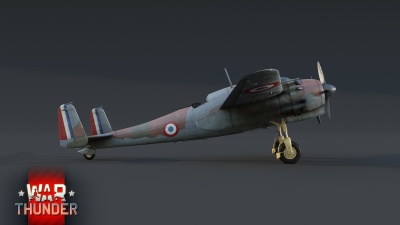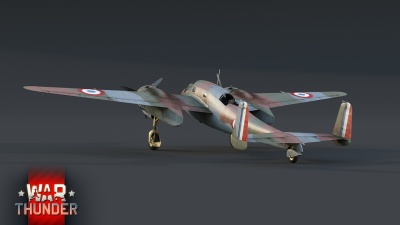Difference between revisions of "Br.693AB2"
(→Description: Updated class) |
m (Preemptively Linking Art) |
||
| (One intermediate revision by one other user not shown) | |||
| Line 1: | Line 1: | ||
{{Specs-Card | {{Specs-Card | ||
| − | |code= | + | |code=br_693_ab2 |
| − | |images={{Specs-Card-Image|GarageImage_{{PAGENAME}}.jpg}} | + | |images={{Specs-Card-Image|GarageImage_{{PAGENAME}}.jpg|ArtImage_{{PAGENAME}}.png}} |
}} | }} | ||
== Description == | == Description == | ||
<!-- ''In the description, the first part should be about the history of and the creation and combat usage of the aircraft, as well as its key features. In the second part, tell the reader about the aircraft in the game. Insert a screenshot of the vehicle, so that if the novice player does not remember the vehicle by name, he will immediately understand what kind of vehicle the article is talking about.'' --> | <!-- ''In the description, the first part should be about the history of and the creation and combat usage of the aircraft, as well as its key features. In the second part, tell the reader about the aircraft in the game. Insert a screenshot of the vehicle, so that if the novice player does not remember the vehicle by name, he will immediately understand what kind of vehicle the article is talking about.'' --> | ||
| − | The '''{{Specs|name}}''' | + | The '''{{Specs|name}}''' is a rank {{Specs|rank}} French strike aircraft {{Battle-rating}}. It was introduced in [[Update 1.93 "Shark Attack"]]. |
| − | |||
| − | |||
| − | |||
| − | |||
== General info == | == General info == | ||
| Line 16: | Line 12: | ||
{{Specs-Avia-Flight}} | {{Specs-Avia-Flight}} | ||
<!-- ''Describe how the aircraft behaves in the air. Speed, manoeuvrability, acceleration and allowable loads - these are the most important characteristics of the vehicle.'' --> | <!-- ''Describe how the aircraft behaves in the air. Speed, manoeuvrability, acceleration and allowable loads - these are the most important characteristics of the vehicle.'' --> | ||
| − | + | The Br.693AB2 has impressive flight characteristics for a plane of its class. The aircraft has a great top speed of almost 500 km/h at higher altitudes when spaded, making it almost as fast as many monoplane fighters of its rank. However, be aware that the aircraft doesn't usually get that high, and is effectively limited to a max speed of 375 km/h in level flight at lower altitudes. The climb rate of this plane is also rather lacklustre, though the plane doesn't typically need to climb for any reason. The aircraft's engines are quite reliable, but will overheat if WEP is applied for too long. | |
| − | + | However, the main advantage of this aircraft are its handling characteristics. The Br.693AB2 has a great set of control surfaces that allow it to be very snappy and responsive for a twin-engined aircraft. The plane has a decent roll rate, and moreover, a great turn rate. This means that it may be able to outturn fighters such as the Bf 109 in a turnfight. That said, the plane's energy retention characteristics are mediocre meaning that extended turning engagements are not recommended. | |
{| class="wikitable" style="text-align:center" width="70%" | {| class="wikitable" style="text-align:center" width="70%" | ||
! rowspan="2" | Characteristics | ! rowspan="2" | Characteristics | ||
| − | ! colspan="2" | Max Speed<br>(km/h at | + | ! colspan="2" | Max Speed<br>(km/h at 4,000 m) |
! rowspan="2" | Max altitude<br>(metres) | ! rowspan="2" | Max altitude<br>(metres) | ||
! colspan="2" | Turn time<br>(seconds) | ! colspan="2" | Turn time<br>(seconds) | ||
| Line 31: | Line 27: | ||
|- | |- | ||
! Stock | ! Stock | ||
| − | | | + | | 471 || 458 || rowspan="2" | {{Specs|ceiling}} || 19.8 || 20.5 || 5.4 || 5.4 || rowspan="2" | 350 |
|- | |- | ||
! Upgraded | ! Upgraded | ||
| − | | | + | | 523 || 495 || 18.8 || 19.0 || 11.0 || 7.8 |
|- | |- | ||
|} | |} | ||
| Line 45: | Line 41: | ||
! Combat flaps !! Take-off flaps !! Landing flaps !! Air brakes !! Arrestor gear | ! Combat flaps !! Take-off flaps !! Landing flaps !! Air brakes !! Arrestor gear | ||
|- | |- | ||
| − | | | + | | ✓ || ✓ || ✓ || X || X <!-- ✓ --> |
|- | |- | ||
|} | |} | ||
| Line 60: | Line 56: | ||
! Combat !! Take-off !! Landing !! + !! - | ! Combat !! Take-off !! Landing !! + !! - | ||
|- | |- | ||
| − | | {{Specs|destruction|body}} || {{Specs|destruction|gear}} || | + | | {{Specs|destruction|body}} || {{Specs|destruction|gear}} || 382 || 320 || 294 || ~10 || ~7 |
|- | |- | ||
|} | |} | ||
| Line 70: | Line 66: | ||
! Ailerons !! Rudder !! Elevators !! Radiator | ! Ailerons !! Rudder !! Elevators !! Radiator | ||
|- | |- | ||
| − | | < | + | | < 300 || < 300 || < 350 || > 320 |
|- | |- | ||
|} | |} | ||
| Line 84: | Line 80: | ||
! WEP Engine power | ! WEP Engine power | ||
|- | |- | ||
| − | | | + | | 3,400 m || 670 hp || 804 hp |
|- | |- | ||
|} | |} | ||
| Line 92: | Line 88: | ||
<!-- ''Examine the survivability of the aircraft. Note how vulnerable the structure is and how secure the pilot is, whether the fuel tanks are armoured, etc. Describe the armour, if there is any, and also mention the vulnerability of other critical aircraft systems.'' --> | <!-- ''Examine the survivability of the aircraft. Note how vulnerable the structure is and how secure the pilot is, whether the fuel tanks are armoured, etc. Describe the armour, if there is any, and also mention the vulnerability of other critical aircraft systems.'' --> | ||
| − | + | * 10 mm steel seat for pilot | |
| + | * 10 mm steel in front of gunner | ||
| + | * Self-sealing fuel tanks (3 in each wing) | ||
=== Modifications and economy === | === Modifications and economy === | ||
| Line 102: | Line 100: | ||
{{Specs-Avia-Offensive}} | {{Specs-Avia-Offensive}} | ||
<!-- ''Describe the offensive armament of the aircraft, if any. Describe how effective the cannons and machine guns are in a battle, and also what belts or drums are better to use. If there is no offensive weaponry, delete this subsection.'' --> | <!-- ''Describe the offensive armament of the aircraft, if any. Describe how effective the cannons and machine guns are in a battle, and also what belts or drums are better to use. If there is no offensive weaponry, delete this subsection.'' --> | ||
| − | {{main| | + | {{main|Hispano 404 (20 mm)|MAC 1934 (7.5 mm)}} |
The '''''{{PAGENAME}}''''' is armed with: | The '''''{{PAGENAME}}''''' is armed with: | ||
| − | * | + | * 1 x 20 mm Hispano 404 cannon, nose-mounted (90 rpg) |
| − | + | * 2 x 7.5 mm MAC 1934 machine guns, nose-mounted (500 rpg = 1,000 total) | |
| − | |||
| − | |||
| − | |||
=== Suspended armament === | === Suspended armament === | ||
{{Specs-Avia-Suspended}} | {{Specs-Avia-Suspended}} | ||
<!-- ''Describe the aircraft's suspended armament: additional cannons under the wings, bombs, rockets and torpedoes. This section is especially important for bombers and attackers. If there is no suspended weaponry remove this subsection.'' --> | <!-- ''Describe the aircraft's suspended armament: additional cannons under the wings, bombs, rockets and torpedoes. This section is especially important for bombers and attackers. If there is no suspended weaponry remove this subsection.'' --> | ||
| − | {{main| | + | {{main|G.A. MMN. 50 (50 kg)}} |
The '''''{{PAGENAME}}''''' can be outfitted with the following ordnance: | The '''''{{PAGENAME}}''''' can be outfitted with the following ordnance: | ||
* Without load | * Without load | ||
| − | * | + | * 8 x 50 kg G.A. MMN. 50 bombs (400 kg total) |
| − | |||
| − | |||
| − | |||
=== Defensive armament === | === Defensive armament === | ||
{{Specs-Avia-Defensive}} | {{Specs-Avia-Defensive}} | ||
<!-- ''Defensive armament with turret machine guns or cannons, crewed by gunners. Examine the number of gunners and what belts or drums are better to use. If defensive weaponry is not available, remove this subsection.'' --> | <!-- ''Defensive armament with turret machine guns or cannons, crewed by gunners. Examine the number of gunners and what belts or drums are better to use. If defensive weaponry is not available, remove this subsection.'' --> | ||
| − | {{main| | + | {{main|MAC 1934T (7.5 mm)}} |
The '''''{{PAGENAME}}''''' is defended by: | The '''''{{PAGENAME}}''''' is defended by: | ||
| − | * 1 x 7.7 mm | + | * 1 x 7.5 mm MAC 1934T machine gun, dorsal turret (500 rpg) |
| + | * 1 x 7.5 mm MAC 1934T machine gun, ventral turret (500 rpg) | ||
| − | + | Note: Both turrets are operated by the same gunner, so both turrets become disabled if the single gunner is knocked out. As well, the ventral turret cannot rotate at all meaning that it is essentially useless in rear defence. | |
== Usage in battles == | == Usage in battles == | ||
<!-- ''Describe the tactics of playing in the aircraft, the features of using aircraft in a team and advice on tactics. Refrain from creating a "guide" - do not impose a single point of view, but instead, give the reader food for thought. Examine the most dangerous enemies and give recommendations on fighting them. If necessary, note the specifics of the game in different modes (AB, RB, SB).'' --> | <!-- ''Describe the tactics of playing in the aircraft, the features of using aircraft in a team and advice on tactics. Refrain from creating a "guide" - do not impose a single point of view, but instead, give the reader food for thought. Examine the most dangerous enemies and give recommendations on fighting them. If necessary, note the specifics of the game in different modes (AB, RB, SB).'' --> | ||
| + | The Br.693AB2 is an excellent starting attacker with forgiving flight characteristics. It can be used for a variety of missions depending on the pilot's needs. The aircraft can be employed as a traditional attacker, destroying softer ground targets. It can also be used as a bomber-hunter or air-defence fighter, making use of its great handling and heavy frontal armament. However, take note that the frontal armament is angled slightly downwards making it slightly harder to aim against air targets. In general, there are two main playstyles / approaches for this aircraft, highlighted below: | ||
| + | |||
| + | '''Ground attack / CAS:''' | ||
| − | + | This strategy utilises the aircraft's strong main armament and secondary bomb payload to destroy enemy targets. Note that the aircraft doesn't carry large bombs or rockets. This is a major limitation, making hard-target destruction impossible unless you have an insane level of accuracy. This means that the aircraft is ideal for destroying softer targets such as AA guns and armoured cars. To attack these, the bombs can be a good option - simply drop 1-2 to destroy a target, and remember to set a bomb fuse timer. The 20 mm Hispano 404 cannon is also quite effective against ground targets, which further increases the lethality of the aircraft. | |
| − | + | In mixed battles, the aircraft can be utilised in the same way. However, the 50 kg bombs are quite ineffective against any hard targets, meaning it would be wise to target softer targets such as SPAAs or SPGs. Just remember to avoid taking too much flak, as the aircraft's fuselage isn't too strong. | |
| + | |||
| + | '''Anti-Air / Bomber hunter:''' | ||
| + | |||
| + | This strategy utilises the aircraft's airspawn, good agility and frontal armament to destroy enemy air targets. At the start of a match, immediately start climbing to reach the highest altitude possible. At that point, start looking for potential targets to engage. Often times, the aircraft's climb rate will prevent you from reaching higher altitudes in time, but lower-flying attackers and bombers are all good targets. | ||
| + | |||
| + | When flying this aircraft in an anti-air role, make sure to fly defensively. Watch for any fighters who look like they might try to Boom & Zoom on you, as the aircraft's airframe isn't too strong and won't be able to tank too much damage. Against early fighters and biplanes, a B & Z strategy works well as the aircraft can attain high speeds in dives. Against faster monoplanes, a more defensive approach must be taken. Some turning can occur but '''never''' get into an extended turn fight as the plane will lose energy quite rapidly in extended turns. | ||
=== Manual Engine Control === | === Manual Engine Control === | ||
| Line 165: | Line 167: | ||
'''Pros:''' | '''Pros:''' | ||
| − | * | + | * Offensive guns are nose-mounted meaning that convergence isn't an issue |
| − | * | + | ** Take note that the guns are tilted slightly downwards, which can take some getting used to in air combat, but makes shooting ground targets easier. |
| − | * | + | * Has surprisingly responsive controls and good manoeuvrability for a twin-engined fighter |
| + | * Main armament is relatively hard-hitting and can also carry some bombs for ground-attack | ||
| + | * Has a dorsal defensive turret with strong firing angles, and a fixed ventral machine gun | ||
| + | * Gets an Airspawn in Realistic battles | ||
| − | '''Cons | + | '''Cons''' |
| − | * | + | * Doesn't carry heavy weapons meaning that it is much more difficult to destroy harder targets |
| − | ** | + | ** Cannot carry rockets or bombs over 50 kg |
| − | * | + | * Lacking climb rate prevents it from getting to bomber altitude in a timely manner |
| − | + | * Ventral machine gun is fixed-firing meaning that the bottom quadrant is virtually unprotected | |
| − | * | ||
| − | |||
| − | |||
| − | |||
== History == | == History == | ||
<!-- ''Describe the history of the creation and combat usage of the aircraft in more detail than in the introduction. If the historical reference turns out to be too long, take it to a separate article, taking a link to the article about the vehicle and adding a block "/History" (example: <nowiki>https://wiki.warthunder.com/(Vehicle-name)/History</nowiki>) and add a link to it here using the <code>main</code> template. Be sure to reference text and sources by using <code><nowiki><ref></ref></nowiki></code>, as well as adding them at the end of the article with <code><nowiki><references /></nowiki></code>. This section may also include the vehicle's dev blog entry (if applicable) and the in-game encyclopedia description (under <code><nowiki>=== In-game description ===</nowiki></code>, also if applicable).'' --> | <!-- ''Describe the history of the creation and combat usage of the aircraft in more detail than in the introduction. If the historical reference turns out to be too long, take it to a separate article, taking a link to the article about the vehicle and adding a block "/History" (example: <nowiki>https://wiki.warthunder.com/(Vehicle-name)/History</nowiki>) and add a link to it here using the <code>main</code> template. Be sure to reference text and sources by using <code><nowiki><ref></ref></nowiki></code>, as well as adding them at the end of the article with <code><nowiki><references /></nowiki></code>. This section may also include the vehicle's dev blog entry (if applicable) and the in-game encyclopedia description (under <code><nowiki>=== In-game description ===</nowiki></code>, also if applicable).'' --> | ||
| − | + | Originally designed in response to a 1934 requirement for a three-seat heavy fighter, the Bréguet Bre.690C.3 (C.3 signifying it was a fighter manned by a 3-man crew) was rejected in favour of the Potez 630C.3 as Bréguet had chosen to ignore weight specifications that it found impossible to meet, instead proposing it to the French military as a multi-purpose aircraft. Following this rejection, Bréguet then revised it as a two-seat attack aircraft, with the navigator's position deleted and replaced by a bomb bay capable of holding 460 kg of bombs, and a revised armament of one fixed forward-firing 20 mm cannon supplemented by 2 forward firing 7.5 mm machine guns, one fixed rearward-firing 7.5 mm machine gun in a ventral position, and one flexible 7.5 mm machine gun manned by the rear gunner. | |
| + | |||
| + | The revised Bre.691AB.2 (AB.2 signifying it was an assault bomber manned by a 2-man crew) first flew in March 1938, leading to a production run of 78 aircraft with Hispano-Suiza 14 engines. Planned production for the Bre.692AB.2 with Gnome-Rhòne 14N engines never went ahead; instead 254 Bre.693AB.2s with Gnome-Rhòne 14M engines were built. Due to a perceived shortage of Gnome-Rhòne engines, Bréguet was also ordered to adapt the design so it could be powered by imported US-built engines: this led to a production run of 50 Bre.695AB.2s powered by Pratt & Whitney R-1830-SB4G Twin Wasp engines. Other projected variants were the Bre.694R.2 reconnaissance version; the Bre.696B.2 bomber version, which had been cancelled in favour of the Bre.693AB.2; and the Bre.697C.2 heavy fighter prototype. | ||
| + | |||
| + | Unfortunately, the Bréguet 690 family saw its career cut short by the Battle of France (May 10 - June 22 1940). France had been late to start the rearmament of its military, originally keeping itself to the strict disarmament treaties of the 1920s, and then finding itself unable to acquire modern military designs due to the economic crisis of the early 1930s. At the time of the German invasion, only 75 of the Bre.691s, 128 of the Bre.693s and 8 of the Bre.695s had been delivered; of these, 119 would go on to be lost during the hectic days of May and June 1940. | ||
| + | |||
| + | While the Bréguet Bre 690 family had been a technically sound design, it was based on an outdated concept: it had been conceived as a low-level, level bomber as the French military did not believe in dive bombers, and thought that tree-top level strafing and bombing of enemy targets gave a better survivability. This was entirely based on the then-current French Army's mobile air defences, which on the one hand consisted of hand-held light calibre machine guns, and on the other hand of World War I vintage slow-firing cannons. By the time the Bre.690 family had started entering service, the French military itself had remedied this defensive gap by the purchase of heavy calibre machine guns and quick-firing cannons; on the German side the Flak 38 had emerged as a potent threat to this flawed tactic, yet despite this no changes were made to the tactical thinking behind the Bréguet Bre.693. | ||
| + | |||
| + | The type saw its first combat on May 12th 1940, when 18 aircraft of the GBA II/54 and I/51 were deployed against German columns advancing through Belgium; the mission quickly revealed the flaws in the level bomber tactic, as the aircraft were easy targets to the quick-firing Flak 38s that were providing cover to the German troops. Out of 18 aircraft, 10 were lost with the loss of 11 crew taken prisoner and 4 crew killed. The disaster prompted the French high command to switch roles of the Bre.690 to that of shallow dive-bomber, a role for which it never had been built: the aircraft lacked a dive-bombing sight and dive brakes, and while the dive-bombing attacks did decrease vulnerability to AA fire, it increased the inaccuracy of its bombing, and made the type more vulnerable to enemy fighters. As a result, 119 of 211 Bréguet 691, 693 and 695s delivered to the French Air Force were lost during the Battle of France with a further 14 too heavily damaged to be repaired. | ||
| + | |||
| + | When defeat became inevitable, the French military started evacuating numerous aircraft to its North African territories in the hope they could continue the fight against Germany from there, but when it came to the Bréguets this proved impossible as they did not have the range to make it across the Mediterranean. The survivors (plus the remainder of the aircraft not yet completed at the time of the French surrender) were pressed into service with the French Vichy Air Force or used as trainers by the Luftwaffe. | ||
| + | |||
| + | Other users of the Bre.690 series were the Italian Regia Aeronautica, which received a small number of Bre.693s as trainers in 1943, and Belgium, which had ordered 32 Bre.694s, and of which the first completed aircraft was undergoing trials in France at the time of the Battle of France. Sweden had placed an order for 12 Bre.694s, to be completed as S10 reconnaissance aircraft, but France fell before any could be built and the order was cancelled as a result. | ||
== Media == | == Media == | ||
<!-- ''Excellent additions to the article would be video guides, screenshots from the game, and photos.'' --> | <!-- ''Excellent additions to the article would be video guides, screenshots from the game, and photos.'' --> | ||
| − | ; | + | ;Images |
| + | <gallery mode="packed" heights="150px"> | ||
| + | File:Bréguet 693 WTWallpaper 001.jpg | ||
| + | File:Bréguet 693 WTWallpaper 002.jpg | ||
| + | File:Bréguet 693 WTWallpaper 003.jpg | ||
| + | File:Bréguet 693 WTWallpaper 004.jpg | ||
| + | File:Bréguet 693 WTWallpaper 005.jpg | ||
| + | </gallery> | ||
| − | + | == See also == | |
| − | + | ''Links to the articles on the War Thunder Wiki that you think will be useful for the reader, for example:'' | |
| − | |||
| − | |||
| − | |||
| − | |||
| − | |||
* ''reference to the series of the aircraft;'' | * ''reference to the series of the aircraft;'' | ||
| − | * ''links to approximate analogues of other nations and research trees.'' | + | * ''links to approximate analogues of other nations and research trees.'' |
| − | |||
| − | |||
| − | |||
| − | |||
| − | |||
| − | |||
== External links == | == External links == | ||
| Line 213: | Line 222: | ||
* ''other literature.'' --> | * ''other literature.'' --> | ||
| − | + | * [[wt:en/news/6430-development-br%C3%A9guet-693a-b2-french-flavoured-ground-attack-en|[Development] Bréguet 693A-B2: French Flavoured Ground Attack]] | |
| − | |||
| − | |||
| − | * [[wt:en/news/ | ||
| − | {{AirManufacturer | + | {{AirManufacturer Breguet}} |
| − | {{ | + | {{France twin-engine fighters and attackers}} |
Revision as of 02:36, 13 September 2021
Contents
Description
The Br.693AB2 is a rank I French strike aircraft with a battle rating of 2.0 (AB) and 1.7 (RB/SB). It was introduced in Update 1.93 "Shark Attack".
General info
Flight performance
The Br.693AB2 has impressive flight characteristics for a plane of its class. The aircraft has a great top speed of almost 500 km/h at higher altitudes when spaded, making it almost as fast as many monoplane fighters of its rank. However, be aware that the aircraft doesn't usually get that high, and is effectively limited to a max speed of 375 km/h in level flight at lower altitudes. The climb rate of this plane is also rather lacklustre, though the plane doesn't typically need to climb for any reason. The aircraft's engines are quite reliable, but will overheat if WEP is applied for too long.
However, the main advantage of this aircraft are its handling characteristics. The Br.693AB2 has a great set of control surfaces that allow it to be very snappy and responsive for a twin-engined aircraft. The plane has a decent roll rate, and moreover, a great turn rate. This means that it may be able to outturn fighters such as the Bf 109 in a turnfight. That said, the plane's energy retention characteristics are mediocre meaning that extended turning engagements are not recommended.
| Characteristics | Max Speed (km/h at 4,000 m) |
Max altitude (metres) |
Turn time (seconds) |
Rate of climb (metres/second) |
Take-off run (metres) | |||
|---|---|---|---|---|---|---|---|---|
| AB | RB | AB | RB | AB | RB | |||
| Stock | 471 | 458 | 9500 | 19.8 | 20.5 | 5.4 | 5.4 | 350 |
| Upgraded | 523 | 495 | 18.8 | 19.0 | 11.0 | 7.8 | ||
Details
| Features | ||||
|---|---|---|---|---|
| Combat flaps | Take-off flaps | Landing flaps | Air brakes | Arrestor gear |
| ✓ | ✓ | ✓ | X | X |
| Limits | ||||||
|---|---|---|---|---|---|---|
| Wings (km/h) | Gear (km/h) | Flaps (km/h) | Max Static G | |||
| Combat | Take-off | Landing | + | - | ||
| 0 | 295 | 382 | 320 | 294 | ~10 | ~7 |
| Optimal velocities (km/h) | |||
|---|---|---|---|
| Ailerons | Rudder | Elevators | Radiator |
| < 300 | < 300 | < 350 | > 320 |
| Compressor (RB/SB) | ||
|---|---|---|
| Setting 1 | ||
| Optimal altitude | 100% Engine power | WEP Engine power |
| 3,400 m | 670 hp | 804 hp |
Survivability and armour
- 10 mm steel seat for pilot
- 10 mm steel in front of gunner
- Self-sealing fuel tanks (3 in each wing)
Modifications and economy
Armaments
Offensive armament
The Br.693AB2 is armed with:
- 1 x 20 mm Hispano 404 cannon, nose-mounted (90 rpg)
- 2 x 7.5 mm MAC 1934 machine guns, nose-mounted (500 rpg = 1,000 total)
Suspended armament
The Br.693AB2 can be outfitted with the following ordnance:
- Without load
- 8 x 50 kg G.A. MMN. 50 bombs (400 kg total)
Defensive armament
The Br.693AB2 is defended by:
- 1 x 7.5 mm MAC 1934T machine gun, dorsal turret (500 rpg)
- 1 x 7.5 mm MAC 1934T machine gun, ventral turret (500 rpg)
Note: Both turrets are operated by the same gunner, so both turrets become disabled if the single gunner is knocked out. As well, the ventral turret cannot rotate at all meaning that it is essentially useless in rear defence.
Usage in battles
The Br.693AB2 is an excellent starting attacker with forgiving flight characteristics. It can be used for a variety of missions depending on the pilot's needs. The aircraft can be employed as a traditional attacker, destroying softer ground targets. It can also be used as a bomber-hunter or air-defence fighter, making use of its great handling and heavy frontal armament. However, take note that the frontal armament is angled slightly downwards making it slightly harder to aim against air targets. In general, there are two main playstyles / approaches for this aircraft, highlighted below:
Ground attack / CAS:
This strategy utilises the aircraft's strong main armament and secondary bomb payload to destroy enemy targets. Note that the aircraft doesn't carry large bombs or rockets. This is a major limitation, making hard-target destruction impossible unless you have an insane level of accuracy. This means that the aircraft is ideal for destroying softer targets such as AA guns and armoured cars. To attack these, the bombs can be a good option - simply drop 1-2 to destroy a target, and remember to set a bomb fuse timer. The 20 mm Hispano 404 cannon is also quite effective against ground targets, which further increases the lethality of the aircraft.
In mixed battles, the aircraft can be utilised in the same way. However, the 50 kg bombs are quite ineffective against any hard targets, meaning it would be wise to target softer targets such as SPAAs or SPGs. Just remember to avoid taking too much flak, as the aircraft's fuselage isn't too strong.
Anti-Air / Bomber hunter:
This strategy utilises the aircraft's airspawn, good agility and frontal armament to destroy enemy air targets. At the start of a match, immediately start climbing to reach the highest altitude possible. At that point, start looking for potential targets to engage. Often times, the aircraft's climb rate will prevent you from reaching higher altitudes in time, but lower-flying attackers and bombers are all good targets.
When flying this aircraft in an anti-air role, make sure to fly defensively. Watch for any fighters who look like they might try to Boom & Zoom on you, as the aircraft's airframe isn't too strong and won't be able to tank too much damage. Against early fighters and biplanes, a B & Z strategy works well as the aircraft can attain high speeds in dives. Against faster monoplanes, a more defensive approach must be taken. Some turning can occur but never get into an extended turn fight as the plane will lose energy quite rapidly in extended turns.
Manual Engine Control
| MEC elements | ||||||
|---|---|---|---|---|---|---|
| Mixer | Pitch | Radiator | Supercharger | Turbocharger | ||
| Oil | Water | Type | ||||
| Controllable | Controllable Not auto controlled |
Controllable Not auto controlled |
Controllable Not auto controlled |
Separate | Not controllable 1 gear |
Not controllable |
Pros and cons
Pros:
- Offensive guns are nose-mounted meaning that convergence isn't an issue
- Take note that the guns are tilted slightly downwards, which can take some getting used to in air combat, but makes shooting ground targets easier.
- Has surprisingly responsive controls and good manoeuvrability for a twin-engined fighter
- Main armament is relatively hard-hitting and can also carry some bombs for ground-attack
- Has a dorsal defensive turret with strong firing angles, and a fixed ventral machine gun
- Gets an Airspawn in Realistic battles
Cons
- Doesn't carry heavy weapons meaning that it is much more difficult to destroy harder targets
- Cannot carry rockets or bombs over 50 kg
- Lacking climb rate prevents it from getting to bomber altitude in a timely manner
- Ventral machine gun is fixed-firing meaning that the bottom quadrant is virtually unprotected
History
Originally designed in response to a 1934 requirement for a three-seat heavy fighter, the Bréguet Bre.690C.3 (C.3 signifying it was a fighter manned by a 3-man crew) was rejected in favour of the Potez 630C.3 as Bréguet had chosen to ignore weight specifications that it found impossible to meet, instead proposing it to the French military as a multi-purpose aircraft. Following this rejection, Bréguet then revised it as a two-seat attack aircraft, with the navigator's position deleted and replaced by a bomb bay capable of holding 460 kg of bombs, and a revised armament of one fixed forward-firing 20 mm cannon supplemented by 2 forward firing 7.5 mm machine guns, one fixed rearward-firing 7.5 mm machine gun in a ventral position, and one flexible 7.5 mm machine gun manned by the rear gunner.
The revised Bre.691AB.2 (AB.2 signifying it was an assault bomber manned by a 2-man crew) first flew in March 1938, leading to a production run of 78 aircraft with Hispano-Suiza 14 engines. Planned production for the Bre.692AB.2 with Gnome-Rhòne 14N engines never went ahead; instead 254 Bre.693AB.2s with Gnome-Rhòne 14M engines were built. Due to a perceived shortage of Gnome-Rhòne engines, Bréguet was also ordered to adapt the design so it could be powered by imported US-built engines: this led to a production run of 50 Bre.695AB.2s powered by Pratt & Whitney R-1830-SB4G Twin Wasp engines. Other projected variants were the Bre.694R.2 reconnaissance version; the Bre.696B.2 bomber version, which had been cancelled in favour of the Bre.693AB.2; and the Bre.697C.2 heavy fighter prototype.
Unfortunately, the Bréguet 690 family saw its career cut short by the Battle of France (May 10 - June 22 1940). France had been late to start the rearmament of its military, originally keeping itself to the strict disarmament treaties of the 1920s, and then finding itself unable to acquire modern military designs due to the economic crisis of the early 1930s. At the time of the German invasion, only 75 of the Bre.691s, 128 of the Bre.693s and 8 of the Bre.695s had been delivered; of these, 119 would go on to be lost during the hectic days of May and June 1940.
While the Bréguet Bre 690 family had been a technically sound design, it was based on an outdated concept: it had been conceived as a low-level, level bomber as the French military did not believe in dive bombers, and thought that tree-top level strafing and bombing of enemy targets gave a better survivability. This was entirely based on the then-current French Army's mobile air defences, which on the one hand consisted of hand-held light calibre machine guns, and on the other hand of World War I vintage slow-firing cannons. By the time the Bre.690 family had started entering service, the French military itself had remedied this defensive gap by the purchase of heavy calibre machine guns and quick-firing cannons; on the German side the Flak 38 had emerged as a potent threat to this flawed tactic, yet despite this no changes were made to the tactical thinking behind the Bréguet Bre.693.
The type saw its first combat on May 12th 1940, when 18 aircraft of the GBA II/54 and I/51 were deployed against German columns advancing through Belgium; the mission quickly revealed the flaws in the level bomber tactic, as the aircraft were easy targets to the quick-firing Flak 38s that were providing cover to the German troops. Out of 18 aircraft, 10 were lost with the loss of 11 crew taken prisoner and 4 crew killed. The disaster prompted the French high command to switch roles of the Bre.690 to that of shallow dive-bomber, a role for which it never had been built: the aircraft lacked a dive-bombing sight and dive brakes, and while the dive-bombing attacks did decrease vulnerability to AA fire, it increased the inaccuracy of its bombing, and made the type more vulnerable to enemy fighters. As a result, 119 of 211 Bréguet 691, 693 and 695s delivered to the French Air Force were lost during the Battle of France with a further 14 too heavily damaged to be repaired.
When defeat became inevitable, the French military started evacuating numerous aircraft to its North African territories in the hope they could continue the fight against Germany from there, but when it came to the Bréguets this proved impossible as they did not have the range to make it across the Mediterranean. The survivors (plus the remainder of the aircraft not yet completed at the time of the French surrender) were pressed into service with the French Vichy Air Force or used as trainers by the Luftwaffe.
Other users of the Bre.690 series were the Italian Regia Aeronautica, which received a small number of Bre.693s as trainers in 1943, and Belgium, which had ordered 32 Bre.694s, and of which the first completed aircraft was undergoing trials in France at the time of the Battle of France. Sweden had placed an order for 12 Bre.694s, to be completed as S10 reconnaissance aircraft, but France fell before any could be built and the order was cancelled as a result.
Media
- Images
See also
Links to the articles on the War Thunder Wiki that you think will be useful for the reader, for example:
- reference to the series of the aircraft;
- links to approximate analogues of other nations and research trees.
External links
| Bréguet Aviation (Société des Ateliers d'Aviation Louis Bréguet) | |
|---|---|
| Attackers | Br.693AB2 |
| France twin-engine fighters and strike aircraft | |
|---|---|
| Twin-engine fighters | Potez 630 · Potez 631 · VB.10C-1 · VB.10-02 |
| Strike aircraft | Br.693AB2 · ▄AD-4 · ▄AD-4NA |


